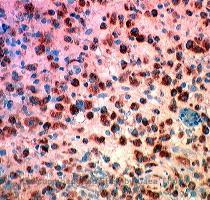HEALTHBEAT: Doctors try testing hotly debated vein fix for MS as some patients want care now
By Lauran Neergaard, APMonday, March 22, 2010
 more images
more images
Testing new MS theory as patients demand care now
WASHINGTON — Under intense pressure from patients, some U.S. doctors are cautiously testing a provocative theory that abnormal blood drainage from the brain may play a role in multiple sclerosis — and that a surgical vein fix might help.
If it pans out, the approach suggested by a researcher in Italy could mark a vast change for MS, a disabling neurological disease long blamed on an immune system gone awry. But many patients frustrated by today’s limited therapies say they don’t have time to await the carefully controlled studies needed to prove if it really works and are searching out vein-opening treatment now — undeterred by one report of a dangerous complication.
“This made sense and I was hell-bent on doing it,” says Nicole Kane Gurland of Bethesda, Md., the first to receive the experimental treatment at Washington’s Georgetown University Hospital, which is set to closely track how a small number of patients fare before and after using a balloon to widen blocked veins.
In Buffalo, N.Y., more than 1,000 people applied for 30 slots in a soon-to-start study of that same angioplasty procedure. When the University at Buffalo team started a larger study a few months ago just to compare if bad veins are more common in MS patients than in healthy people — not to treat them — more than 13,000 patients applied.
The demand worries Georgetown neurologist Dr. Carlo Tornatore, who teamed with vascular surgeon Dr. Richard Neville in hopes of getting some evidence to guide his own patients’ care.
“A lot of people are starting to go to fly-by-night places,” says Tornatore. Doing this research takes time, he said. “It’s a marathon, not a 100-yard sprint. We have to be very careful.”
Multiple sclerosis occurs when the protective insulation, called myelin, that coats nerve fibers gradually is destroyed and scar tissue builds up, short-circuiting messages from the brain and spinal cord to the rest of the body — impairing walking and causing fatigue and vision, speech, memory and other problems. It affects about 2.5 million people worldwide, including 350,000 Americans.
A condition with an unwieldy name has become the hottest topic of debate in MS: Chronic cerebrospinal venous insufficiency, or CCSVI. An Italian vascular specialist, Dr. Paolo Zamboni, was hunting ways to help his wife’s MS when he discovered that veins carrying oxygen-depleted blood down the neck or spinal cord were narrowed, blocked or twisted in a group of patients. Zamboni reported that made blood back up in a way that might be linked to MS’ damage, by causing tiny leaks of immune cells into the brain that start a cascade of inflammatory problems.
Then came the step that spread excitedly through MS patient Internet forums: In a pilot study, Zamboni’s team used balloon angioplasty — similar to a longtime method for unclogging heart arteries — to widen affected veins in 65 patients. He reported varying degrees of improvement, mostly in patients with the relapsing-remitting form of MS who experienced fewer flare-ups of symptoms over the next 18 months and some improvements in quality of life.
But nearly half had their veins relapse, and Zamboni urged a larger, more scientifically controlled study be done.
Next, Buffalo researchers scanned the veins of 500 people. About 55 percent of MS patients had signs of CCSVI, compared with 22 percent of healthy people, says lead researcher Dr. Robert Zivadinov, who will present his data next month at a major neurology meeting.
Meanwhile, a Stanford University surgeon tried implanting scaffolding-like stents — also developed for heart disease — into some MS patients’ narrowed veins. Dr. Michael Dake halted the work in December after 35 people were treated, saying in an e-mail to colleagues that he decided “after deep soul-searching” not to continue outside of a clinical trial. Stanford won’t discuss details, but the journal Annals of Neurology reported that one patient’s stent dislodged and flowed to the heart, requiring emergency open-heart surgery to remove it. (An earlier death was reported by family members to be from a stroke unrelated to the MS treatment.)
The MS Society soon will announce funding for additional studies.
Like many neurologists, Georgetown’s Tornatore watched the developments with a mixture of skepticism and curiosity. After all, decades ago some doctors first suggested circulation might play a role. The scars tend to cluster near veins, and blood-thinning treatment was tried before immune-targeting drugs were proven to help many MS patients.
He ticks off the possibilities: This could be a blind alley, like so many to befall MS over the years. Or it could work a little. Or it might be revolutionary.
“I have no idea. I’m not predisposed to any of them,” Tornatore says.
But he and Neville decided angioplasty was the least risky option for a limited test. In 30 patients who’ve undergone a $400 ultrasound exam so far, about half have evidence of the vein abnormality.
Gurland was the first treated earlier this month, her jugular veins blocked so tightly that Neville had a hard time even pushing the tiny angioplasty wire inside. But right after the treatment, Gurland’s feet that for years had been cold and purplish became warmer and normally colored.
What about MS’ hallmark fatigue and weakness, and her scarred nerve cells? While Gurland thinks her balance in the morning, often her worst time, is improving a bit, it’s too soon to know; those tests are yet to come.
But last week, her close friend Heather Tuck, 61, came in for a vein check, too — calling it the first MS test she ever hoped to pass.
EDITOR’S NOTE — Lauran Neergaard covers health and medical issues for The Associated Press in Washington.
On the Net:
Buffalo study: www.bnac.net
Georgetown: www.georgetownuniversityhospital.org
MS Society: www.nationalmssociety.org
Tags: Buffalo, Diagnosis And Treatment, Diseases And Conditions, Heart Health, Multiple Sclerosis, New York, North America, Surgical Procedures, United States, Washington
|
March 26, 2010: 5:31 am
It is always a dangerous thing to try and combine two separate investigations and treat them as they are the same. They are not!!! There are different people and different situations that take place. You also might want to study up on the the same. |
|
March 24, 2010: 1:41 am
Hi, |



bariatric surgery